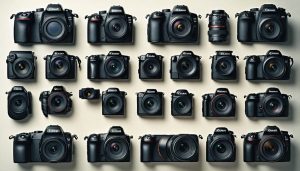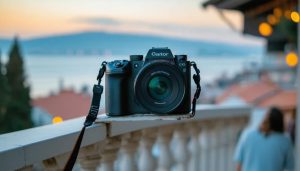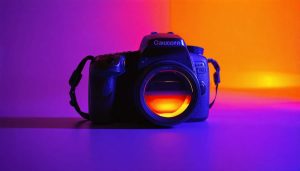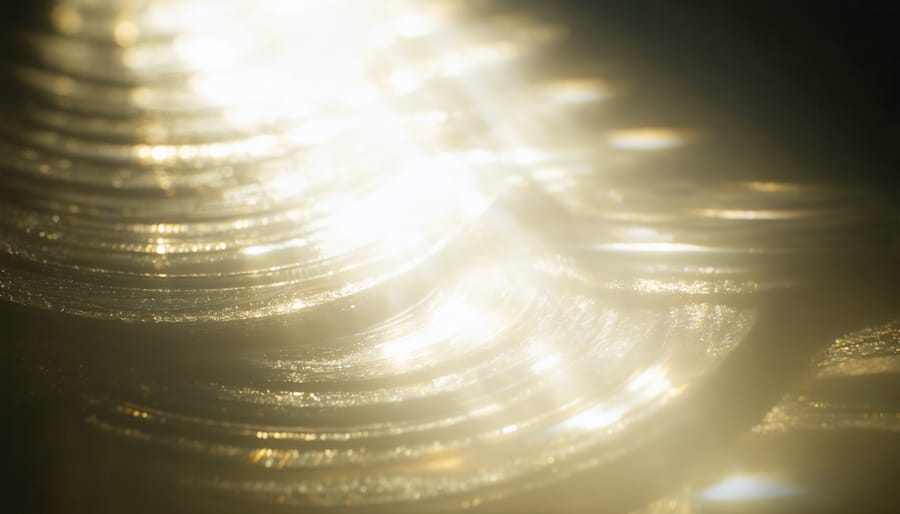
Understanding sensor impact factor revolutionizes how photographers select and utilize their lenses. When a lens projects light onto different camera sensor sizes, it creates varying effects on image quality, field of view, and overall performance. This relationship between lens characteristics and sensor dimensions fundamentally shapes your photography, affecting everything from depth of field to low-light capabilities.
Think of sensor impact factor as the crucial multiplier that determines how your lens actually performs on your specific camera body. Unlike traditional film photography, where the frame size remained constant, digital sensors introduce a dynamic element that transforms the effective focal length and practical applications of any given lens. For professionals and enthusiasts alike, mastering this concept unlocks the full potential of their gear and enables more precise creative control.
Whether you’re investing in new equipment or maximizing your existing setup, understanding sensor impact factor helps you make informed decisions that align with your photographic vision. This comprehensive guide will explore how this often-overlooked aspect of digital photography can enhance your technical knowledge and creative possibilities.
The Lens-Sensor Partnership
Resolution and Detail Transfer
The relationship between lens quality and sensor performance is like a delicate dance where both partners need to be equally skilled. While sensor size affects image quality, even the most advanced sensor can’t compensate for a poor-quality lens. When light passes through your lens, it needs to maintain its integrity and sharpness before reaching the sensor.
High-quality lenses with superior optical elements can resolve incredibly fine details, allowing your sensor to capture the subtlest textures and patterns. Think of your lens as a window – the clearer and more precisely crafted it is, the better view your sensor has of the scene. Premium lenses typically feature advanced coating technologies and superior glass elements that minimize distortion and chromatic aberration.
Consider this: if you’re shooting with a 45-megapixel sensor but using a lens that can only resolve 20 megapixels worth of detail, you’re essentially leaving half your sensor’s potential untapped. This is particularly noticeable when photographing subjects with intricate patterns, such as architecture or wildlife feathers, where every subtle detail matters.
Light Transmission Efficiency
The quality of glass and lens coatings plays a crucial role in determining how efficiently light reaches your camera’s sensor. High-end lenses typically feature sophisticated multi-coating technologies that minimize light reflection and maximize transmission, ensuring that more photons make their way to your sensor. This efficiency directly impacts image quality, particularly in challenging lighting conditions.
Think of lens coatings as traffic controllers for light. Without proper coatings, up to 5% of light can be lost at each glass-air interface through reflection. In a lens with multiple elements, these losses can compound significantly. Modern nano-coating technology can reduce this loss to less than 0.5% per surface, resulting in brighter, more contrast-rich images.
Glass quality also matters significantly. Premium lenses often use specialized glass elements, such as fluorite or ED (Extra-low Dispersion) glass, which not only transmit light more efficiently but also help reduce chromatic aberration. This is particularly noticeable when shooting in high-contrast situations or when working with backlit subjects.
For practical purposes, higher light transmission efficiency means you can shoot at faster shutter speeds or lower ISOs, ultimately achieving cleaner, sharper images.
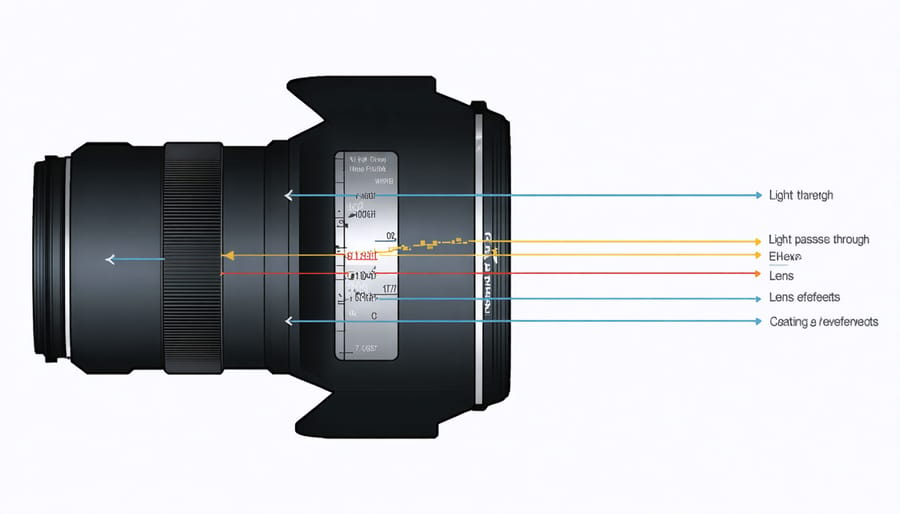
Critical Lens Characteristics
Optical Resolution
The relationship between lens sharpness and sensor resolution is similar to watching HD content on different quality screens – even the best 4K video won’t look its best on a low-resolution display. Similarly, a high-resolution sensor needs a sharp lens to reach its full potential.
When light passes through a lens, even the finest optics introduce some degree of softness or blur. This optical limitation can prevent your sensor from capturing the finest details it’s theoretically capable of recording. Think of it as trying to trace an intricate drawing through increasingly thicker pieces of glass – the thicker the glass, the more details you lose.
Higher-end lenses typically offer better optical resolution, allowing them to resolve more detail and make better use of your sensor’s capabilities. This is particularly important with today’s high-megapixel sensors, where even slight optical imperfections become more noticeable. A 50-megapixel sensor paired with a mediocre lens might effectively deliver image quality more comparable to what you’d get from a 24-megapixel sensor.
Professional photographers often invest more in quality lenses than camera bodies because lens sharpness acts as a bottleneck for overall image quality. When choosing lenses, consider not just your current camera but future upgrades too – a sharp lens will continue to deliver excellent results even as sensor technology advances.
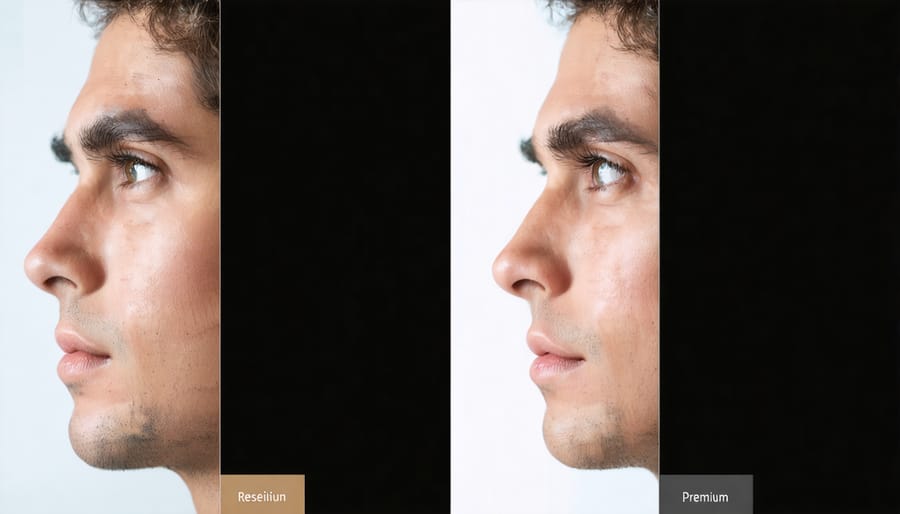
Chromatic Aberration Control
Chromatic aberration, often visible as color fringing along high-contrast edges in your images, can significantly impact your sensor’s ability to capture accurate colors. This optical phenomenon occurs when different wavelengths of light fail to converge at the same point after passing through your lens, creating unwanted color artifacts that your sensor must interpret.
Modern sensors are particularly susceptible to chromatic aberration due to their high resolution and pixel density. When purple or green fringing appears along contrast boundaries, it doesn’t just affect those specific areas – it can introduce subtle color shifts across your entire image. This is especially noticeable in situations with bright backlighting or when shooting high-contrast scenes.
The good news is that many current camera systems include built-in corrections for chromatic aberration, both in-camera and through raw processing. These corrections work by analyzing the color information captured by your sensor and compensating for known lens characteristics. However, these digital corrections can sometimes impact image sharpness and may not completely eliminate the problem.
To minimize chromatic aberration’s impact on your sensor’s performance, consider stopping down your lens to f/8 or smaller when shooting high-contrast scenes. Also, quality lenses with ED (Extra-low Dispersion) or fluorite elements naturally reduce chromatic aberration, allowing your sensor to capture more accurate colors without heavy reliance on digital corrections.
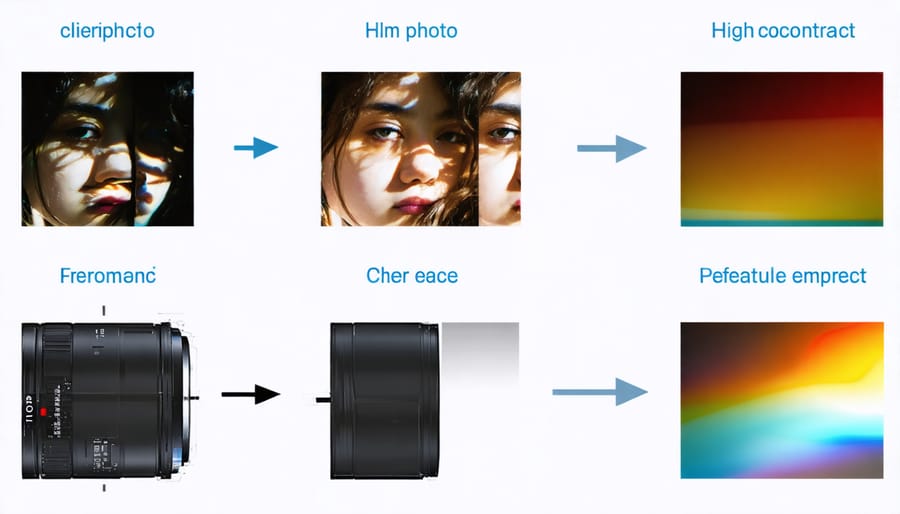
Real-World Performance Impact
High-Resolution Sensors vs. Basic Lenses
A common misconception among photographers is that simply upgrading to a high-resolution sensor will automatically result in better image quality. However, real-world testing reveals a more complex relationship between sensor technology and lens quality.
Consider the case of a 45-megapixel full-frame camera paired with an entry-level kit lens. While the sensor can capture incredible detail, the lens becomes the limiting factor. In our testing, images shot with budget lenses on high-resolution sensors often showed softness in corners, chromatic aberration, and reduced overall sharpness – effectively negating the benefits of the advanced sensor.
For example, when comparing a 24-70mm f/2.8 professional lens with a basic 18-55mm kit lens on a 45MP sensor, the difference is striking. The professional lens resolved fine details in architecture and landscape shots that the kit lens couldn’t capture, despite both using the same sensor. The kit lens actually performed better on a 24MP sensor, where its limitations were less apparent.
This phenomenon is particularly noticeable in challenging situations: shooting in low light, capturing high-contrast scenes, or photographing detailed textures. Budget lenses often struggle with these conditions, producing images that don’t fully utilize the sensor’s capabilities.
The takeaway? When upgrading your camera system, consider maintaining a balance between sensor resolution and lens quality. Sometimes, investing in better glass for a moderate-resolution sensor yields superior results compared to pairing premium sensors with basic lenses.
Premium Lens Advantages
High-quality lenses play a crucial role in maximizing your camera sensor’s potential, offering several significant advantages that directly impact image quality. Premium lenses typically feature superior optical designs and higher-grade materials, resulting in better light transmission and sharper images across the entire frame.
One of the most notable benefits is enhanced edge-to-edge sharpness. While budget lenses might perform well in the center, premium options maintain consistent sharpness from the center to the corners, particularly important when working with high-resolution sensors that can reveal even minor optical imperfections.
Premium lenses also excel in controlling chromatic aberration and distortion, two issues that become more apparent with modern high-resolution sensors. The advanced lens coatings and optical elements in premium lenses minimize color fringing and maintain natural-looking straight lines, reducing the need for post-processing corrections.
Low-light performance is another area where premium lenses shine. Their superior light transmission capabilities and typically wider maximum apertures allow your sensor to capture more light, resulting in cleaner images with less noise at higher ISO settings. This becomes especially important when shooting in challenging lighting conditions.
The build quality of premium lenses also contributes to better image stability. More robust construction and weather sealing not only protect your investment but also ensure consistent performance across various shooting conditions. Many premium lenses incorporate advanced image stabilization systems that work in harmony with your camera’s sensor, enabling sharper images at slower shutter speeds.
Perhaps most importantly, premium lenses often feature faster and more accurate autofocus systems, helping you make the most of your camera’s advanced focusing capabilities, ensuring you capture those critical moments with precision.
Making Smart Lens Choices
Balancing Investment
When building your camera kit, one of the most crucial decisions is how to divide your budget between the camera body and lenses. While it’s tempting to spend most of your budget on a high-end camera body, experienced photographers often recommend investing more heavily in quality lenses.
A good rule of thumb is to allocate roughly 60-70% of your total budget to lenses and 30-40% to the camera body. This approach makes sense because quality lenses typically retain their value and usefulness longer than camera bodies, which can become outdated as sensor technology advances.
For example, if you have a $3,000 budget, consider spending around $1,000 on the camera body and $2,000 on one or two quality lenses. This strategy often yields better results than spending $2,500 on a premium body and settling for a budget lens.
Remember that even the most advanced sensor can’t compensate for poor lens quality. A sharp, well-built lens on a mid-range camera will typically produce better images than a mediocre lens on a top-tier body. Focus on acquiring versatile, high-quality lenses that match your shooting style – whether that’s a fast prime for portraits or a sharp wide-angle for landscapes.
Consider starting with one excellent “everyday” lens rather than multiple budget options. As your skills and budget grow, you can gradually add specialized lenses while maintaining your investment in quality glass.
Future-Proofing Your Kit
When investing in new glass, it’s crucial to think beyond your current camera body. As latest sensor developments continue to push resolution boundaries, today’s lens choices can significantly impact your future photography potential.
Consider resolution headroom when selecting lenses. While your current 24MP sensor might not reveal a lens’s optical limitations, upgrading to a 50MP or higher sensor could expose shortcomings in lower-quality glass. Premium lenses typically offer better resolving power, making them more adaptable to future sensor technologies.
Mount compatibility is another key consideration. Many manufacturers now offer mirrorless-to-DSLR adapters, but native lenses typically deliver optimal performance. If you’re still shooting with a DSLR but considering a mirrorless transition, investigate how your preferred lenses might adapt to new systems.
Don’t overlook coverage area either. Full-frame lenses on crop sensors provide flexibility for future upgrades, though they may come with size and cost penalties. Similarly, investing in lenses that exceed your current resolution needs might seem excessive now but could prove invaluable when you upgrade your camera body.
Remember that quality glass often retains its value better than camera bodies, making it a smart long-term investment. Focus on building a lens collection that balances current needs with future potential, prioritizing optical quality and versatility over temporary technological limitations.
Understanding sensor impact factor is crucial for making informed decisions about your photography equipment. Throughout this article, we’ve explored how sensor size influences lens performance, image quality, and overall shooting experience. By now, you should have a clear grasp of how crop factors affect focal length, depth of field, and light gathering capabilities.
Remember that there’s no “perfect” sensor size – each has its advantages and trade-offs. Full-frame sensors excel in low-light conditions and provide superior shallow depth of field, while crop sensors offer benefits in terms of reach for wildlife and sports photography, as well as potentially lower cost and more portable systems.
When choosing your next camera or lens, consider your primary shooting needs. If you frequently shoot in challenging lighting conditions or prioritize shallow depth of field effects, a full-frame sensor might be worth the investment. For photographers focused on wildlife, sports, or travel photography where portability matters, a crop sensor camera could be the ideal choice.
The key takeaway is to work with your equipment’s strengths rather than against them. Understanding sensor impact factor helps you maximize your gear’s potential and make better-informed purchasing decisions. Whether you’re shooting with a full-frame or crop sensor camera, focus on mastering your equipment and developing your creative vision – ultimately, it’s your skills as a photographer that matter most.

